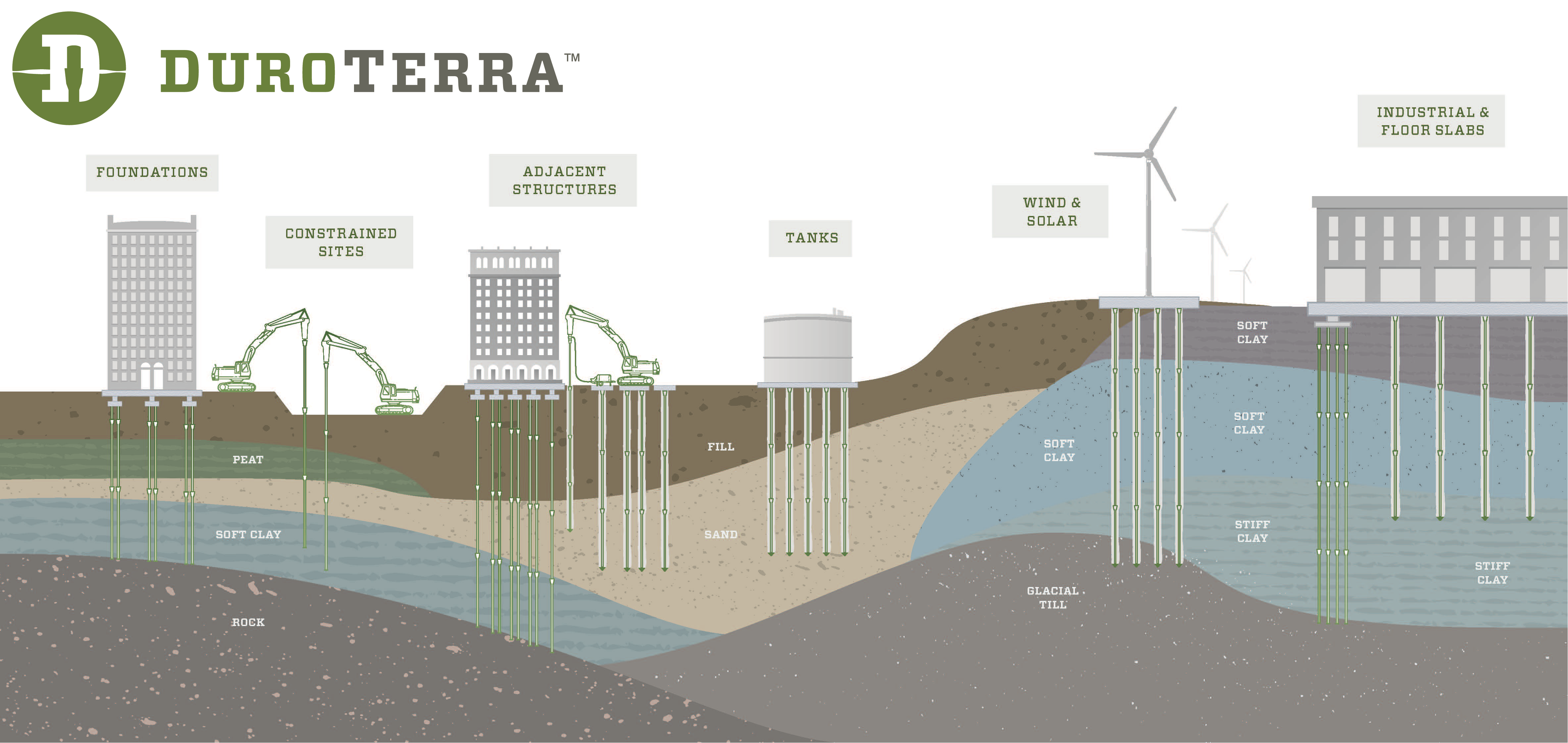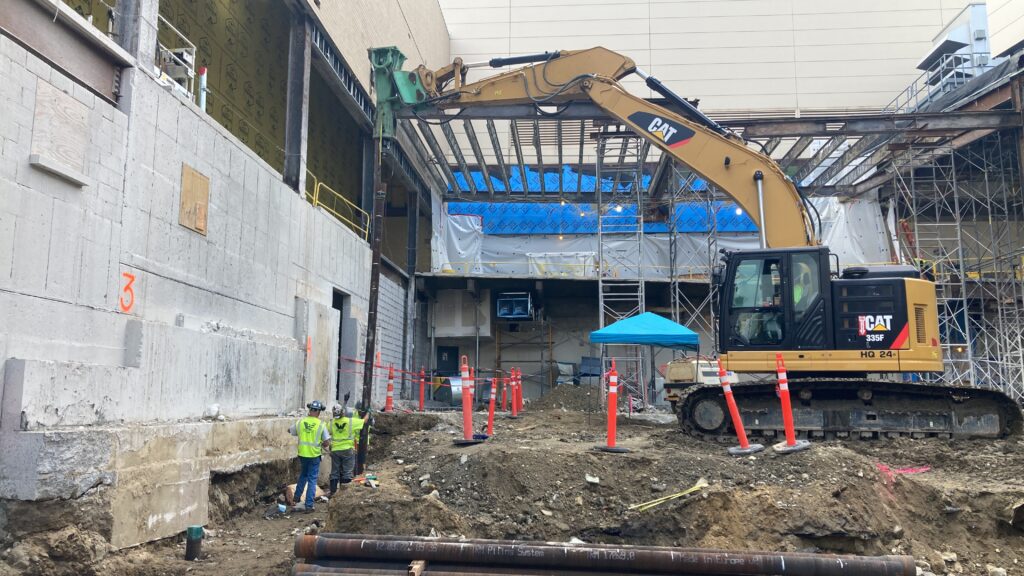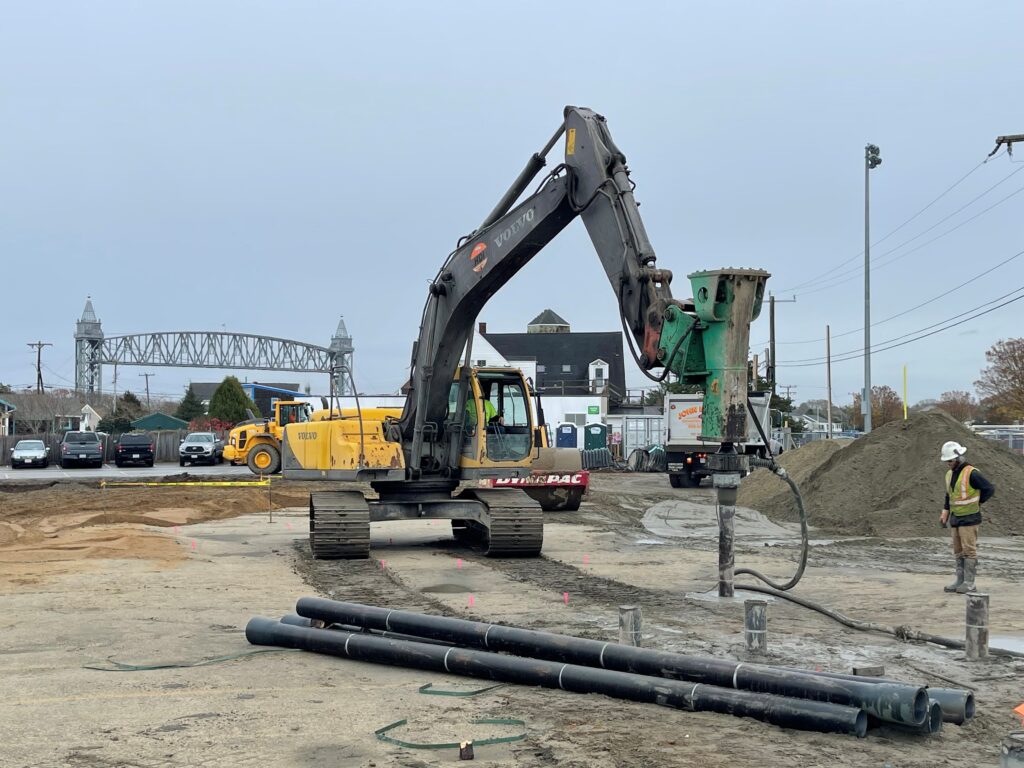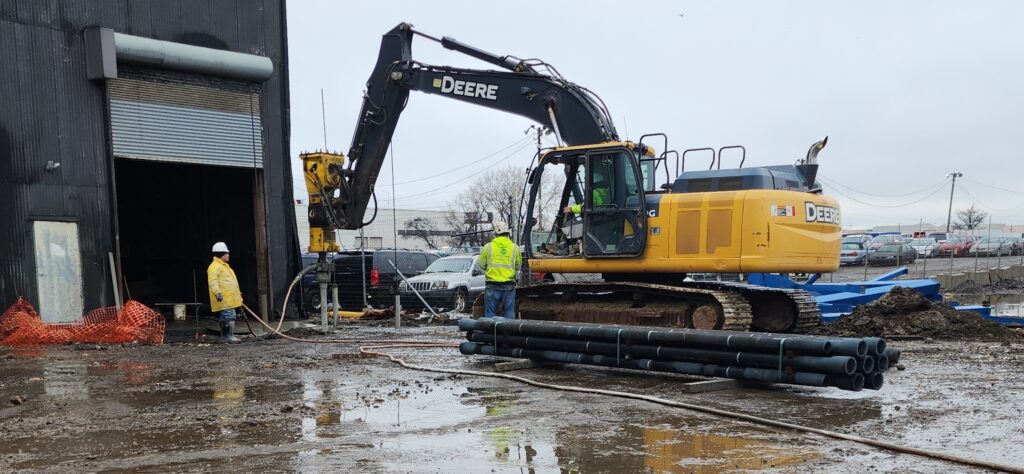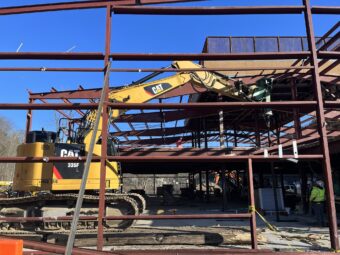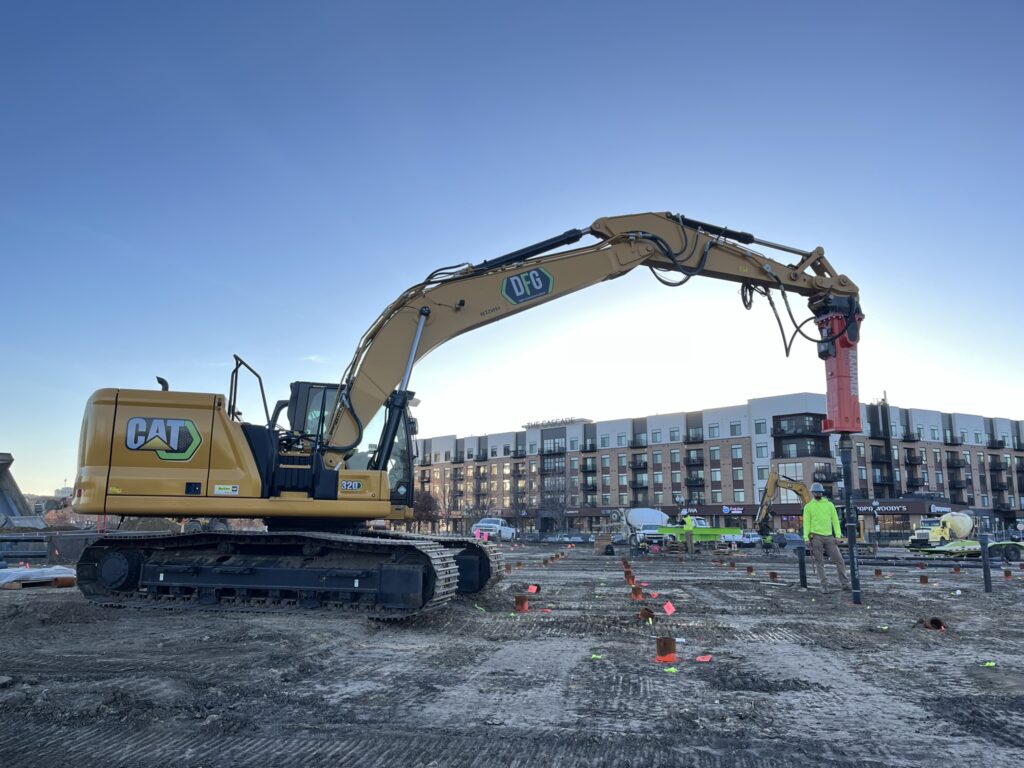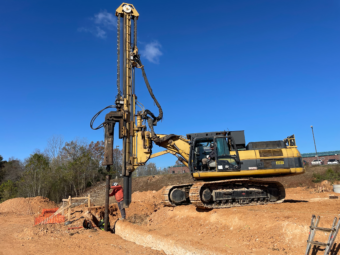Axial Load Testing of Ductile Iron Piles
Unlike other deep foundation systems that may rely only on correlations as indicators of capacity, Ductile Iron Piles are routinely load tested to verify performance and confirm design capacities. One of the more frequent questions that arises is what type of load testing can be performed on Ductile Iron Piles (DIPs). In most cases, this innovative low-vibration driven pile is tested using traditional testing methods. But some pile-specific limitations must be considered in planning a test program. The following provides a brief summary of applicability of common test methods used with Ductile Iron Piles.
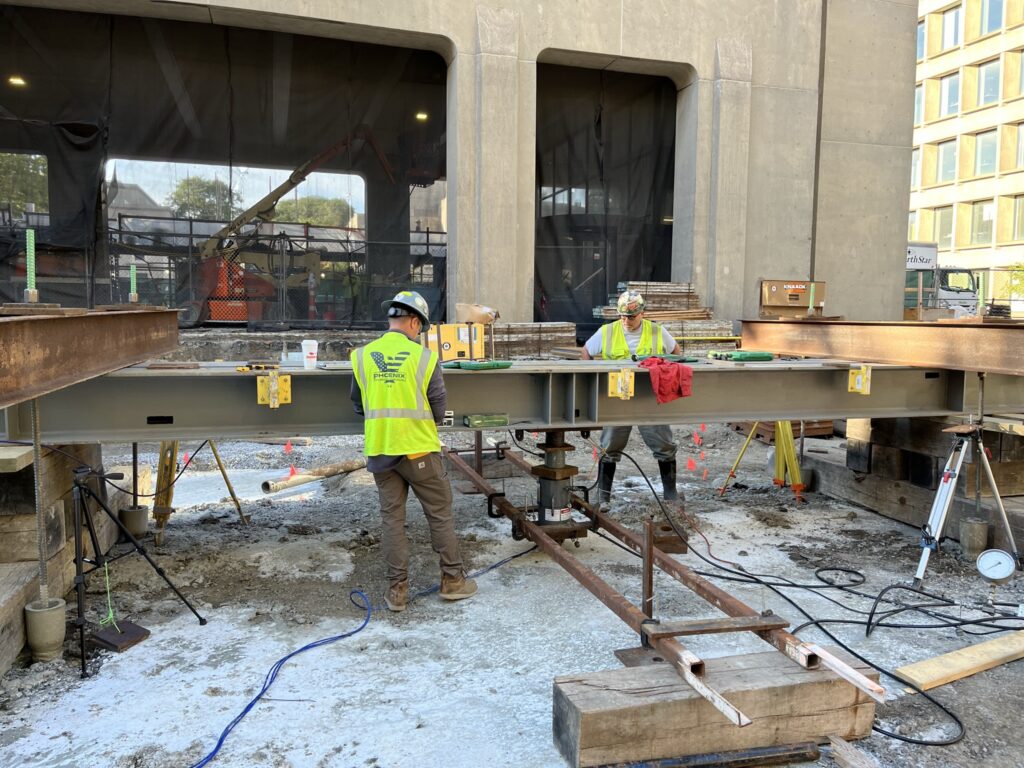
Setting up a Compression Load Test on a Ductile Iron Pile
Compression Load Testing (ASTM D1143) – Traditional full-scale compression load testing using reaction piles is by far the most common type of load testing performed on DIPs with hundreds of tests performed in the U.S. A non-production test pile is driven in place using the same equipment and methods anticipated for production piles. Instrumentation (telltales, strain gauges, etc) are often incorporated in the test pile. For reaction piles, exterior grouted friction DIPs are often used. For this application, center threadbars are wet-set in the DIPs and designed to carry the tensile loads. A shallow, debonded concrete thrust block can be used to minimize any lateral movement of the top of the test pile and to maintain lateral stability during testing. The load test is performed up to 200% of the design load and rebounded. Compression load testing has been performed up to 500 kips on Ductile Iron Piles.
Tension Load Testing (ASTM D3689) – In certain situations, Ductile Iron Pile capacities can be verified using tension load testing. Tension testing is performed in situations where the geotechnical side friction requires verification. This is most commonly associated with testing of exterior grouted friction DIPs (i.e. grouted displacement) where the controlling performance mechanism is the geotechnical resistance along the perimeter of the pile. This is similar to micropiles installed within a soil matrix. A center threadbar is wet-set into the center of the grouted test pile. The threadbar is sized to resist the full test load along with an adequate safety factor for testing. Tests are performed up to 200% of the design load and rebounded. Depending on the application, various loading schedules may be used. Tension testing is often less involved and less expensive than compression load testing because of the elimination of the reaction piles as well as thrust block requirements. However, tension testing would not be appropriate for piles generating capacity through tip resistance.
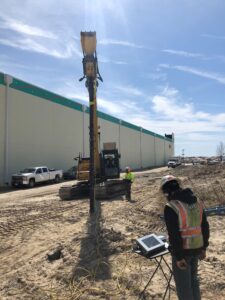 High Strain Dynamic Load Testing (ASTM D4945) – High strain dynamic testing or PDA testing is frequently used on traditional driven pile projects. While this testing procedure can be used with Ductile Iron Piles, the testing is often limited due to the high frequency, low amplitude energy associated with the percussion hammers used for installation. Specifically, these hammers operate at rates of 300 to 600 cycles/minute and the energy per single blow is insufficient to generate enough tip movement to verify the full design capacity. Instead, a separate, high energy pile hammer or drop-weight device is typically required to obtain meaningful PDA test results. While the mobilization of this additional equipment may be desirable on large projects, it may be cost-prohibitive on smaller projects, making a full-scale test more appropriate.
High Strain Dynamic Load Testing (ASTM D4945) – High strain dynamic testing or PDA testing is frequently used on traditional driven pile projects. While this testing procedure can be used with Ductile Iron Piles, the testing is often limited due to the high frequency, low amplitude energy associated with the percussion hammers used for installation. Specifically, these hammers operate at rates of 300 to 600 cycles/minute and the energy per single blow is insufficient to generate enough tip movement to verify the full design capacity. Instead, a separate, high energy pile hammer or drop-weight device is typically required to obtain meaningful PDA test results. While the mobilization of this additional equipment may be desirable on large projects, it may be cost-prohibitive on smaller projects, making a full-scale test more appropriate.
Besides confirming ultimate capacities, dynamic testing has been used during driving to monitor the pile installation and has provided useful learnings. In a recent presentation as a part of Deep Foundation Institute’s IMPACT Webinar series, Alex Ryberg, P.E. of GRL Engineers, Inc. shared observations from dynamic testing of Ductile Iron Piles, specifically related to the Plug & Drive connection. Ryberg observed that the “friction weld appears to be conclusively formed during installation.” While this finding was not unexpected, the information adds to the body of knowledge for the Ductile Iron Pile Plug & Drive connection, providing geotechnical designers with additional validating data related to this unique feature of the DIP system.
Statnamic™ Load Testing (ASTM D7383) – Developed by Applied Foundation Testing, Statnamic load testing uses the burning of special fuel within a cylinder and ram to react against a heavy mass to induce a load impulse on the test pile. The load-deflection behavior of the pile is monitored in response to the applied impulse load. Statnamic testing eliminates the need for reaction piles, hydraulic jack or standard test beam setup. While not commonly used for Ductile Iron Pile testing, this testing approach has been used on occasion for projects in Florida where mobilization of the equipment was minimal.
Load testing of Ductile Iron Piles is a critical part of the design verification process. Geotechnical contractors have a variety of options for testing, and the best option usually comes down to which method can provide the best overall value to members of the project team. While DuroTerra is not directly involved in performing the load testing of Ductile Iron Piles, our engineers can provide insight on test selection, setup and interpretation based on past experiences on a range of projects with a wide variety of geotechnical conditions and logistical constraints.
PROJECT EXPERIENCE – BOSTON COLLEGE CONTE FORUM
Renovations to the existing Boston College Conte Forum basketball arena involved construction of a new 35,700 sq ft practice facility. The project required demolition of a portion of the existing facility, re-use of some existing foundations and construction of new foundations with loads up to 600 kips. Given the tight site access, vibration sensitivity and potential for low overhead restrictions, the project team specified drilled micropiles and Ductile Iron Piles with a capacity of 75 tons as options for foundation support. DIPs were selected based on both cost and schedule savings. A compression test was performed on a 30-ft long Series 170/9.0 Ductile Iron Pile installed through variable fill and glacial till to terminate on rock. The test resulted in about 0.7 inches of movement at 150 tons (200% DL) and confirmed more than 100% of the design load was transferred to the pile tip during the test to satisfy the MA State Building Code.
PROJECT EXPERIENCE – MASS MARITIME ACADEMY CADET HOUSING
Construction of a new 3-story, 30,700 square foot housing development on the campus required support to transfer loads through the fill and organic soils to the underlying medium dense to dense sand and gravel. In addition, the piling system needed to resist lateral loads induced from a possible storm surge given the proximity to the Cape Cod Canal. Ductile Iron Piles were selected as a cost-effective alternative over Pressure-Injected Footings (PIFs). The exterior grouted displacement piles were designed with lengths of 25 ft to develop bonding in the underlying sand and gravel to meet a capacity of 50 tons (compression) and 2 tons (lateral). Testing was performed using a tension load test with an instrumented center bar. The Series 170/9.0 pile installed with a 270 mm (10.6”) diameter grout shoe was first tested up to 100 tons (200% DL) and rebounded. After successfully completing the required testing, the pile was reloaded up to 150 tons (300% DL) in tension to evaluate performance. The pile deflected approximately 0.5 inches at 300% of the design load. The 108 production piles were then installed in only 7 days. For more information, check out the project summary.

